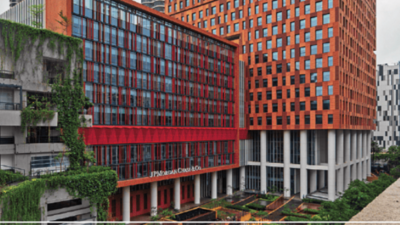ARTICLE AD BOX

TECH THAT: A JPMorgan Chase office in Mumbai
NEW DELHI/BENGALURU: Even though President Trump’s $10,000 H-1B bomb — if it survives legal challenges — is bound to drive up operational costs for tech firms, Fortune 500 companies and global multinationals are accelerating their bets on India.
If companies cannot get Indians to work in the US because of the prohibitive costs, the companies will look to work in India — through GCCs (global capability centres).Positioned as the world’s GCC capital, India offers a powerful trifecta: deep-tech talent, significant cost efficiency, and freedom from crippling visa bottlenecks. With more than 2,600 GCCs already operating, the country has cemented its role as a global engine for innovation, enterprise resilience and business continuity.“Either you can get Indians to work in the US or get work to India,” said Manoj Marwah, financial services GCC sector leader at EY India. “With visa costs going up, the latter is more likely.”In other words, more companies are likely to will bring work and GCCs to India to tap the scale, talent, and cost competitiveness offered by hubs like Delhi NCR and other cities. “The silver lining is that it will stop brain drain from India and the talent will now be available to contribute to the growth of the domestic economy,” Marwah added.
Lalit Ahuja, founder of Bengaluruand US-based ANSR, which has helped establish over 150 GCCs in India, said: “With total costs per H-1B worker now exceeding $3,00,000 annually, a senior software architect, for example, can be employed in a GCC to deliver identical output at a fraction of the cost. This change is not about cost anymore — it’s about strategic advantage. Companies that view this as merely a cost increase will struggle, while those who recognise it as an opportunity to accelerate their GCC strategies will thrive.
” Ahuja emphasised that GCCs have always been a lever to navigate immigration uncertainties. “The proposed increase in H-1B fee will now accelerate both GCC adoption and scaling-up. Additionally, we can now expect a lot of Indian professionals employed in the US on H-1B visas or considering opportunities in the US to look very favourably at opportunities with GCCs in India.”We could look forward to “Less H-1Bs, more hiring of native talent, increased GCC, and more automation with AI,” felt Ray Wang, CEO of Constellation Research. “It is a double-edged sword,” said Raman Roy, CMD of Quatrro BPO Solutions. “On the positive side, the expensive H-1B visas will give a boost to more local sourcing and increase the number of GCCs. However, it could impact the transfer of expertise from US to India.
”



.png)
.png)
.png)
















 2 hours ago
6
2 hours ago
6









 English (US) ·
English (US) ·